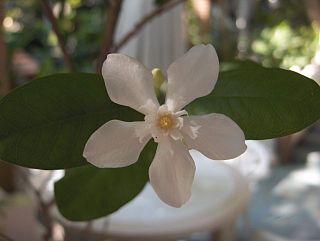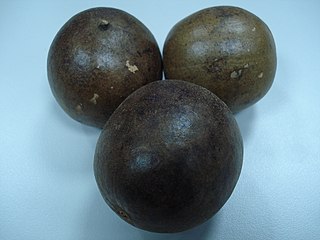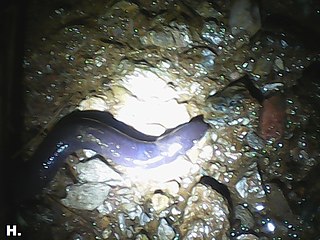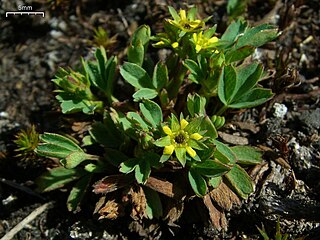
Wrightia is a genus of flowering plants in the family Apocynaceae, first described as a genus in 1810. It native to tropical Africa, China, the Indian Subcontinent, Southeast Asia, Papuasia, and Australia. The species are all small trees or shrubs.

Siraitia is a genus of plants from the family Cucurbitaceae. The following species have been assigned to it, at various times:
Haplogroup F is a human mitochondrial DNA (mtDNA) haplogroup. The clade is most common in East Asia and Southeast Asia. It has not been found among Native Americans.

Ichthyophis sikkimensis, the Sikkimese caecilian or Darjeeling caecilian, is a species of caecilian found in India, Nepal and possibly Bhutan. It was described by Edward Harrison Taylor in 1960.

Actinodaphne is an Asian genus of flowering plants in the laurel family (Lauraceae). It contains approximately 125 species of dioecious evergreen trees and shrubs.

Malus sikkimensis is a rare species of apple known by the common name Sikkim crabapple. Its Chinese name is xi jin hai tang (锡金海棠). It is native to China, Nepal, Bhutan, Assam, Tibet and parts of India, where it is threatened due to loss of habitat.

Evecliptopera is a monotypic moth genus in the family Geometridae described by Inoue in 1982. Its only species, Evecliptopera decurrens, first described by Frederic Moore in 1888, is found in northern India, Nepal, south-western China, Japan, the Russian Far East and Taiwan.

Synuchus is a genus in the beetle family Carabidae. There are more than 80 described species in Synuchus.
Cyathopus is a genus of Himalayan plants in the grass family. The only known species is Cyathopus sikkimensis, native to the mountains of Bhutan, Yunnan, Sikkim, Nepal, Uttarakhand, and nearby regions.

Bamboo shoots or bamboo sprouts are the edible shoots of many bamboo species including Bambusa vulgaris and Phyllostachys edulis. They are used as vegetables in numerous Asian dishes and broths. They are sold in various processed shapes and are available in fresh, dried, and canned versions.

Stauropus is a genus of moths of the family Notodontidae first described by Ernst Friedrich Germar in 1812.

Primula sikkimensis is a species of flowering plant in the family Primulaceae, native to the Himalayan region at altitudes of 3,200–4,400 m (10,499–14,436 ft), from western Nepal to south west China. It is an herbaceous perennial growing to 90 cm (35 in) tall by 60 cm (24 in) broad, with umbels of fragrant yellow flowers, appearing in summer on slender stems which arise from basal rosettes of leaves. The flowers may be covered by a mealy-white layer (farina).
Venusia sikkimensis is a moth in the family Geometridae first described by William Warren in 1893. It can be found in Bhutan, Nepal, India and China.
Berberis sikkimensis is a plant species native to the high Himalayas at elevations of 2000–3000 m. It is known from Sikkim, Nepal, Bhutan, Tibet and Yunnan.
Bhutaniella is a genus of Asian huntsman spiders that was first described by Peter Jäger in 2000.

Sibbaldia is a genus of flowering plants of the family Rosaceae, with a circumpolar distribution, including the high Arctic. The type species is Sibbaldia procumbens. It is also in the Rosoideae subfamily.

Chinese irredentism refers to irredentist claims to territories of the former Chinese Empire made by the Republic of China (ROC) and subsequently the People's Republic of China (PRC).

Euphorbia sikkimensis, called the Sikkim spurge, is a species of flowering plant in the genus Euphorbia, native to Nepal, the eastern Himalayas, Tibet, south-central and southeast China, Myanmar, and Vietnam. It grows in alpine meadows, sparse forests, and scrub. It has gained the Royal Horticultural Society's Award of Garden Merit.














